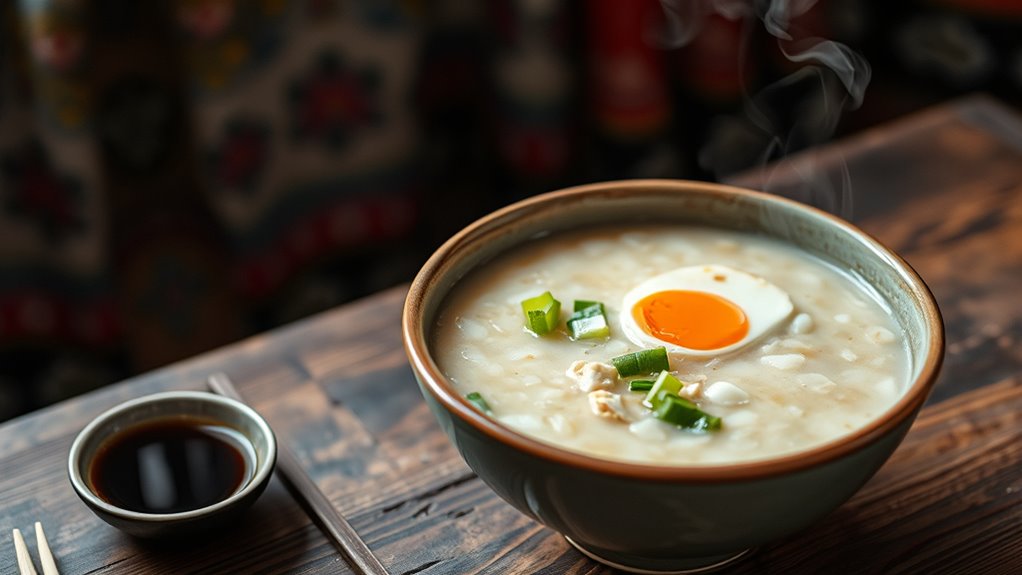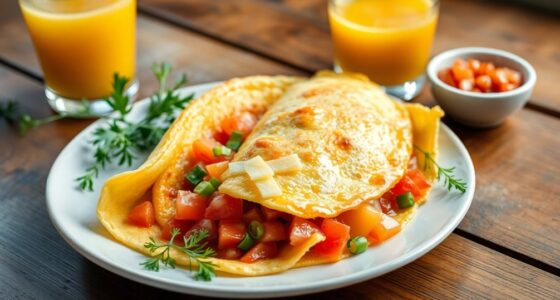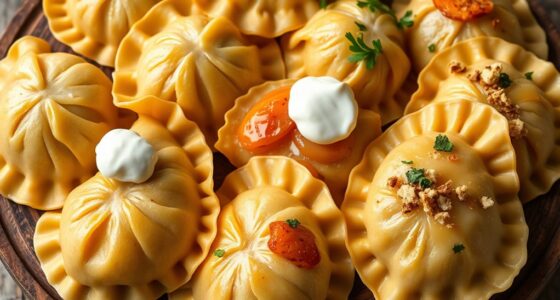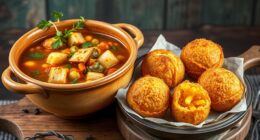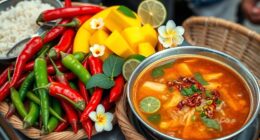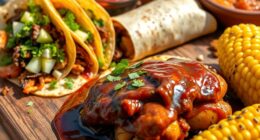Congee is a versatile rice porridge that serves as a comforting breakfast across many Asian cultures. In China, it’s a daily staple often enjoyed with various toppings, while Japan’s okayu offers a gentle, simple version perfect for recovery. Southeast Asian countries add regional flavors like herbs, chili, and lime, making each variation unique. If you’re curious how these diverse styles connect through history and tradition, there’s more to explore about this beloved dish.
Key Takeaways
- Congee is a traditional rice porridge with deep cultural roots across China, Japan, Southeast Asia, and beyond.
- It varies regionally, incorporating local ingredients like herbs, spices, and toppings to reflect diverse tastes.
- Congee serves as a nourishing breakfast, comfort food, and social symbol fostering community and familial bonds.
- Modern innovations include fusion flavors, alternative grains, and culinary techniques to keep it relevant.
- Its adaptability and cultural significance make congee a universal morning staple across Asian societies.
The Origins and Cultural Significance of Congee
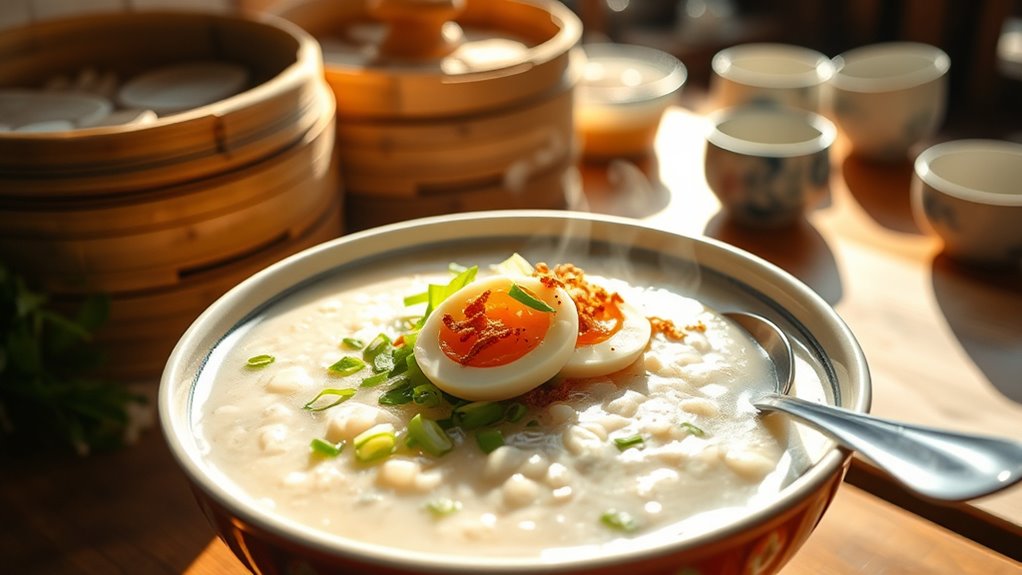
Congee has been a staple in Asian cultures for centuries, serving as more than just a simple rice porridge. Its origins trace back thousands of years, rooted in ancient China, where it was valued for its nourishing qualities. Over time, different regions adapted congee to fit local tastes, making it a symbol of comfort and sustenance. In many cultures, congee represents family bonds and tradition, often prepared during special occasions or as a healing food for the sick. Its versatility allowed it to evolve beyond a basic meal, becoming a cultural icon that reflects local values, ingredients, and history. You can see its importance not only as food but as a meaningful part of cultural identity across Asia. Additionally, the diversification into healthier options has helped maintain its popularity amid changing dietary preferences.
Congee in China: A Traditional Breakfast and Beyond
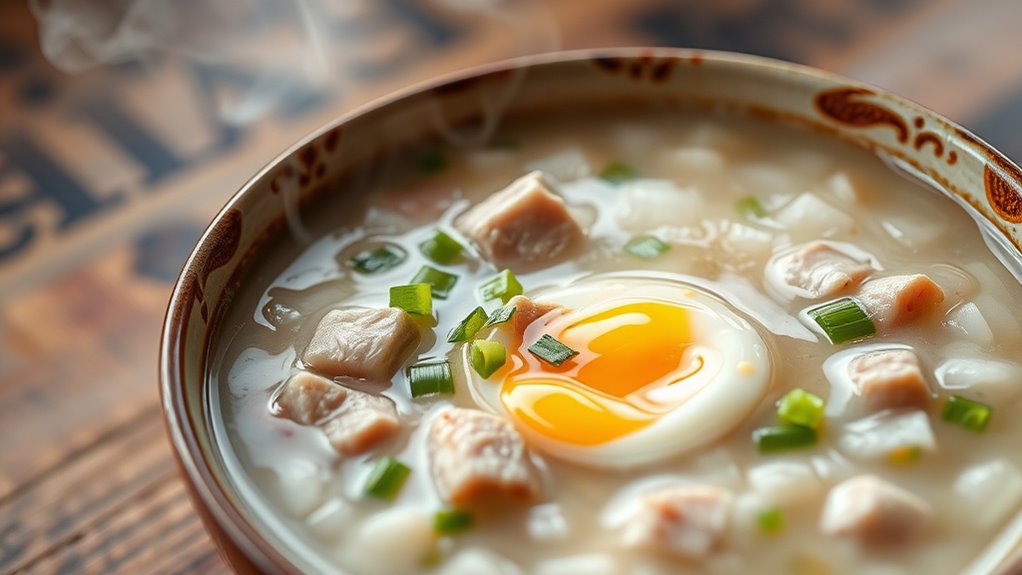
In China, congee is more than just a breakfast staple; it’s a versatile dish that plays a vital role in daily life. You might find it served in bustling street stalls, family kitchens, or high-end restaurants. Congee’s comforting, creamy texture is perfect for customizing with toppings. Imagine:
- A bowl topped with shredded chicken, spring onions, and a dash of soy sauce, ready to energize your morning.
- Thick, savory congee with preserved egg and pork, offering hearty flavors perfect for colder days.
- A simple, delicate version with just a splash of ginger, ideal for soothing a sore throat or settling digestion.
This flexibility makes congee a symbol of nourishment and tradition, enjoyed across generations and social classes in China.
Japan’s Okayu: A Gentle, Nourishing Congee Variant
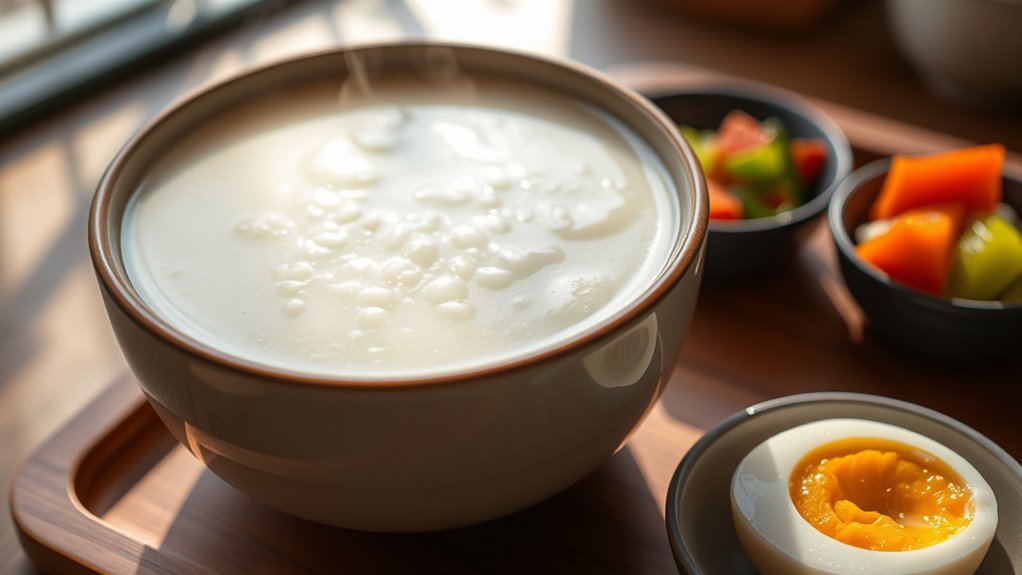
Japan’s okayu offers a soothing twist on the traditional congee, prized for its gentle, easily digestible qualities. Unlike thicker rice porridge, okayu has a softer, more liquid consistency, making it ideal for breakfast or when you’re feeling under the weather. It’s typically made by simmering rice with plenty of water or stock until it reaches a smooth, porridge-like texture. You can enjoy it plain or add toppings like pickles, salted salmon, or umeboshi for flavor. Often served warm and comforting, okayu is a go-to for nourishing mornings and recovery. Its simplicity highlights Japan’s appreciation for subtlety and balance in food, emphasizing nourishment that soothes both body and mind. It’s a gentle way to start your day or restore your energy.
Congee in Southeast Asia: Flavors and Variations
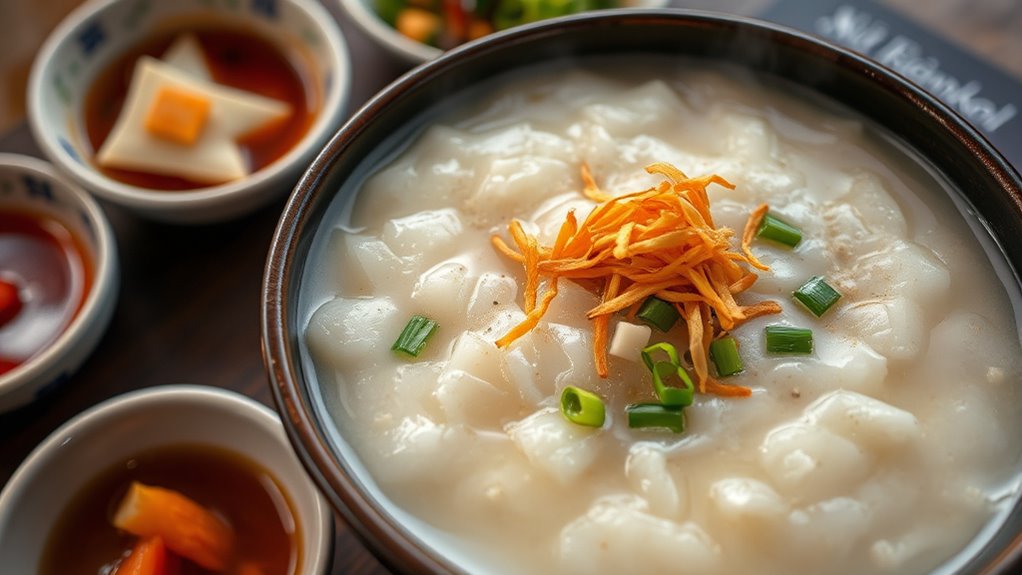
Across Southeast Asia, rice porridge takes on vibrant flavors and unique variations that reflect local ingredients and culinary traditions. You might enjoy a bowl topped with fresh herbs and spicy chili in Thailand, giving it a bright, aromatic punch. In Vietnam, congee often features shredded chicken, scallions, and a squeeze of lime—creating a tangy, savory experience. The use of local ingredients allows each country to develop its own distinctive style of congee. Meanwhile, in Indonesia, you find bubur ayam, a creamy version garnished with crispy fried shallots, chopped peanuts, and a dash of soy sauce. These regional twists showcase how congee adapts to local tastes and ingredients. Interestingly, the adaptation of traditional dishes like congee parallels the regional culinary diversity seen in different countries, reflecting how local conditions shape culinary and financial landscapes. Imagine:
- A bowl with fragrant lemongrass and ginger in Vietnam
- A spicy, chili-laden serving in Thailand
- A hearty, chicken-filled version topped with crunchy garnishes in Indonesia
Korean Juk: A Heartwarming Congee Experience
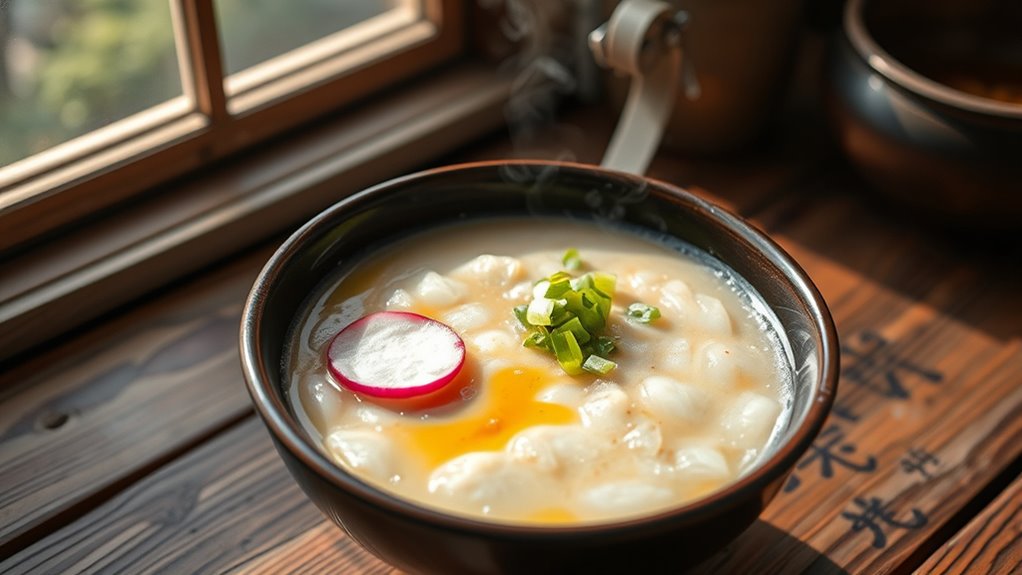
Korean juk offers a comforting take on rice porridge, blending simple ingredients with rich flavors to create a heartwarming dish. It’s often enjoyed as a nourishing breakfast, especially when you’re feeling under the weather. Typically, juk is made by slowly simmering rice with water or broth until it becomes thick and smooth. You might add ingredients like chicken, beef, or seafood for added depth, along with vegetables and seasonings like ginger or garlic. Topping it with scallions, sesame oil, or a soft-boiled egg enhances the flavor and texture. Juk’s gentle warmth and creamy consistency make it a soothing start to your day, providing both comfort and nutritional benefits in every spoonful. Its texture and flavor are influenced by contrast ratio, which determines the richness and clarity of the broth and ingredients. Additionally, the simmering process ensures the ingredients meld together for a harmonious taste. A well-balanced ingredient harmony is essential to achieve the perfect flavor profile in juk. It’s a simple yet deeply satisfying Korean culinary tradition.
Modern Twists and Contemporary Congee Recipes
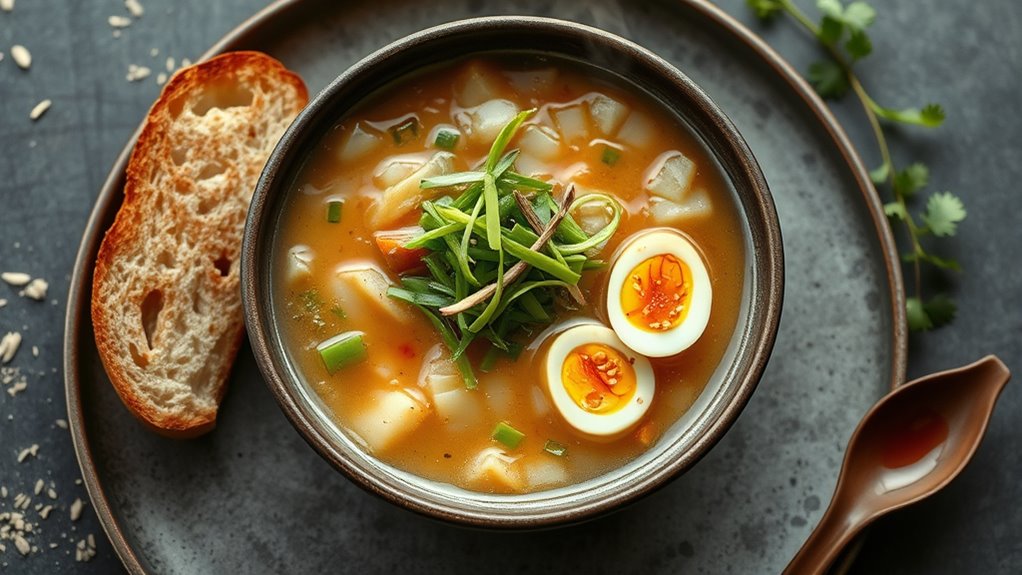
Contemporary chefs and home cooks are putting innovative spins on traditional congee by blending global flavors and modern cooking techniques. You might find a bowl infused with spicy kimchi, adding a tangy kick, or one topped with crispy shallots and a drizzle of truffle oil for luxury. Imagine a congee where quinoa replaces rice for a healthier twist, or a fusion version with curry spices inspired by Indian cuisine. These creative adaptations include:
- Kimchi and gochujang-infused congee for a spicy, tangy breakfast.
- Truffle oil and mushroom toppings for an indulgent, earthy flavor.
- Quinoa-based congee offering a gluten-free, protein-rich alternative.
- Incorporating modern cooking techniques such as sous-vide or fermentation to enhance flavor complexity and texture. Additionally, experimenting with alternative grains like millet or barley can introduce new textures and nutritional benefits to traditional congee recipes. These innovative approaches demonstrate how culinary creativity can transform a simple dish into a versatile, contemporary meal.
- Exploring cultural influences, such as incorporating ingredients or methods from different culinary traditions, to create unique and diverse congee variations. Understanding nutritional benefits of different grains and ingredients can help in crafting more balanced and healthful dishes.
The Universal Comfort of Congee: Connecting Cultures
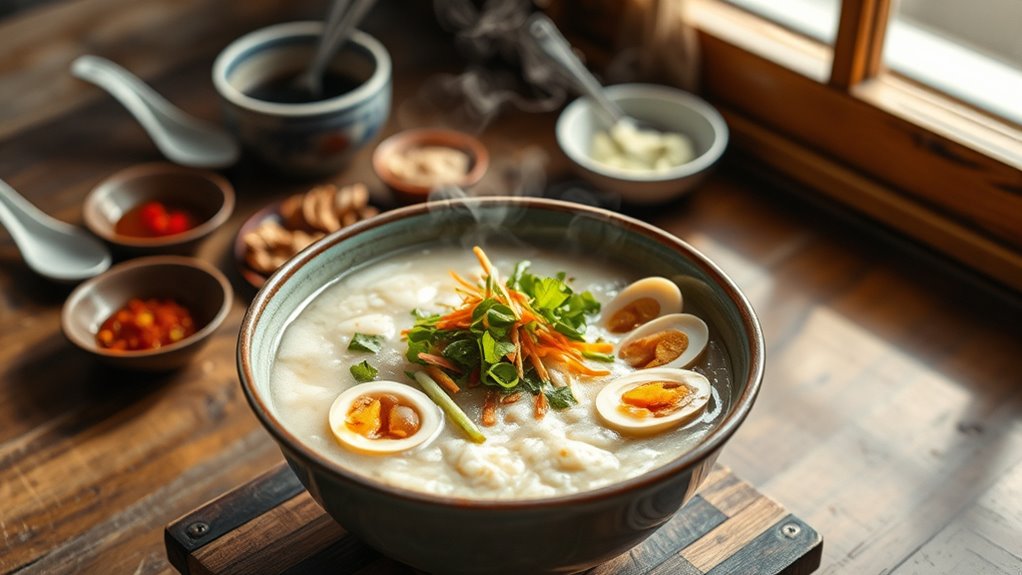
Congee has an extraordinary ability to bring people together, serving as a comforting staple in many Asian cultures and beyond. It’s a dish that transcends borders, offering familiarity and warmth regardless of where you are. Whether you’re in China, India, Thailand, or even the Philippines, congee connects you to shared traditions and family bonds. Its versatility allows each culture to adapt it to local ingredients and flavors, creating a sense of community through variation. When you share a bowl of congee, you’re participating in a centuries-old tradition that celebrates nourishment and connection. Additionally, congee’s cultural significance often intertwines with family traditions, reinforcing its role in fostering social bonds. It’s more than just breakfast; it’s a symbol of hospitality and care that unites diverse peoples under a common culinary language. Recognizing the importance of emotional connection in food traditions helps deepen our appreciation for dishes like congee as a powerful cultural connector. The cultural diversity of congee highlights its adaptability and universal appeal across different societies. Furthermore, the use of a variety of ingredients demonstrates how flexible the dish can be while still maintaining its comforting qualities. Exploring regional variations reveals how local tastes influence this beloved dish, enriching its cultural significance worldwide.
Frequently Asked Questions
How Do Different Grains Influence Congee’S Flavor and Texture?
You’ll notice that different grains give congee unique flavors and textures. For example, rice makes it creamy and smooth, perfect for absorbing toppings. Barley adds a nutty taste and a slightly chewy texture, while millet creates a lighter, fluffier consistency. Each grain influences how thick or runny the congee becomes and how it feels in your mouth, allowing you to customize your bowl based on your taste preferences and desired comfort.
What Are Common Toppings and Accompaniments for Congee Across Asia?
Ever wonder why congee’s toppings are so wildly diverse? You’ll find everything from salted eggs and pickled vegetables in China to century eggs and fried dough in Hong Kong, or shredded chicken and scallions in Korea. These accompaniments add flavor, texture, and cultural flair. Whether you prefer sweet or savory, toppings turn plain rice porridge into a personalized, comforting masterpiece, celebrating regional traditions with every spoonful.
How Is Congee Prepared for Medicinal or Health Purposes?
You prepare congee for medicinal or health purposes by choosing nutrient-rich ingredients like ginger, garlic, or goji berries to boost immunity. You use a higher water-to-rice ratio, simmering it slowly until it becomes a smooth, easily digestible porridge. Sometimes, you add herbs or medicinal herbs, adjusting the ingredients based on specific health needs. This gentle preparation helps retain the nutrients and makes it easier on your digestive system.
Are There Vegetarian or Vegan Congee Options Available?
Yes, you can find vegetarian and vegan congee options easily. Many recipes use vegetable broth instead of meat-based ones, and toppings like mushrooms, tofu, and vegetables add flavor and texture. You can customize congee to suit your dietary preferences, making it a warm, comforting, and nourishing meal. Just ask at your local restaurant or prepare it at home using plant-based ingredients for a delicious, cruelty-free breakfast.
What Are Traditional Festivals or Occasions Featuring Congee?
You’ll be amazed how congee takes center stage during festivals! In China, families gather during the Lunar New Year to enjoy congee as a symbol of good luck. In Japan, it’s essential during New Year’s celebrations, while in Korea, hot bowls of congee mark Chuseok, honoring ancestors. These festivals turn congee into more than a meal—it’s a sacred tradition that unites generations and celebrates cultural heritage with every comforting spoonful.
Conclusion
As you savor congee’s comforting warmth, remember it’s like a gentle hug shared across cultures. Whether you’re in China, Japan, Korea, or Southeast Asia, each bowl connects you to centuries of tradition and family love. Just as a simple spoonful can soothe a restless child or start a busy morning, congee’s universal warmth reminds us that comfort truly knows no borders. Embrace it, and let each spoonful nourish your soul.
